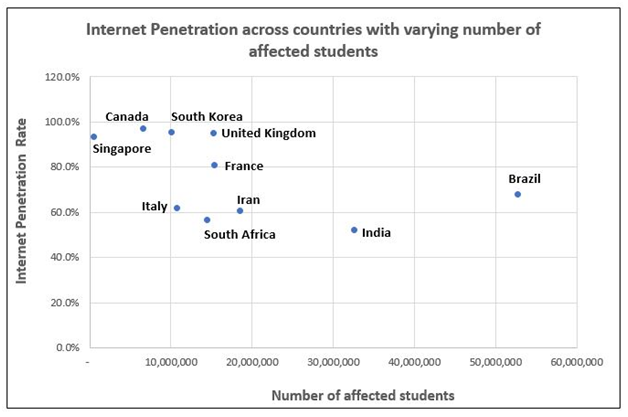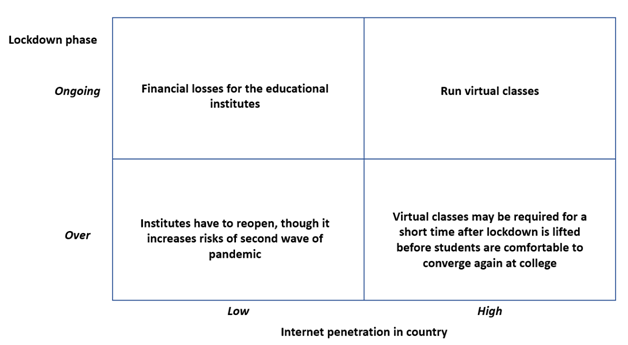The world, for generations, had not seen a disaster bigger than the COVID-19. The entire world has come to a standstill and economies across the globe have slowed down. People from all walks of life have been adversely affected. One of the areas that COVID-19 has had led adverse effects on is the education sector. Schools and colleges have mandatorily been closed in some countries that have nation-wide lockdown for containing the spread of COVID-19.
A glimpse at the number of affected students in ten countries mentioned below shows approximately 0.178 million students facing challenges in learning.
| Country | Affected Learners | Females Affected | Males Affected | Females in preprimary | Males in preprimary | Females in primary | Males in primary | Females in secondary | Males in secondary | Females in tertiary | Males in tertiary |
| Brazil | 52,898,349 | 26,579,822 | 26,318,527 | 2,494,186 | 2,607,749 | 7,716,415 | 8,390,397 | 11,620,916 | 11,497,263 | 4,871,958 | 3,699,465 |
| Canada | 6,643,213 | 3,361,618 | 3,281,595 | – | – | 1,152,755 | 1,211,871 | 1,355,363 | 1,297,646 | 911,217 | 714,361 |
| France | 15,462,340 | 7,697,382 | 7,764,958 | 1,252,548 | 1,308,689 | 2,100,142 | 2,209,800 | 3,092,949 | 2,965,381 | 1,379,311 | 1,153,520 |
| India | 32,713,810 | 158,158,233 | 162,555,577 | 4,557,249 | 5,447,169 | 72,877,621 | 70,349,806 | 69,160,694 | 63,983,677 | 16,739,686 | 17,597,908 |
| Iran | 18,635,825 | 9,048,166 | 9,587,659 | 349,658 | 356,435 | 4,096,819 | 4,074,848 | 2,954,145 | 2,730,093 | 1,871,596 | 2,202,231 |
| Italy | 10,876,792 | 5,354,356 | 5,522,436 | 736,433 | 799,060 | 1,386,624 | 1,515,755 | 2,392,547 | 2,209,322 | 1,021,977 | 815,074 |
| Singapore | 600,587 | 297,882 | 302,705 | – | – | 114,693 | 119,960 | 88,091 | 83,228 | 99,961 | 94,654 |
| South Africa | 14,612,546 | 7,380,765 | 7,231,781 | 426,889 | 435,306 | 3,688,961 | 3,893,193 | 2,440,141 | 2,612,039 | 652,876 | 463,141 |
| South Korea | 10,181,358 | 4,701,823 | 5,479,535 | 629,273 | 661,838 | 1,297,233 | 1,384,582 | 1,604,152 | 1,467,885 | 1,307,432 | 1,828,963 |
| United Kingdom | 15,401,612 | 7,758,645 | 7,642,967 | 860,028 | 903,097 | 2,351,953 | 2,468,330 | 3,218,242 | 3,168,075 | 1,378,589 | 1,053,298 |
(Data sourced from UNESCO COVID-19 Educational Disruption and Response )
Going forward, it does call for unprecedented measures in the redesign of education curriculum. Schools and colleges that run on a rigid schedule and format are now squirming to identify ways of teaching that will help them recover the months lost to the pandemic.
In case the schools remain closed for a few more months,it can wreak havoc on the finances of the institutes, and it is intimidating. During the lockdown, institutes have two options to choose from – either cease all operations or continue inthe virtual realm. Halting the operations simply translates to a fatal attack on the coffers as the delays in fee collection from incoming students and enrolled students will severely impact the balance sheets of the institutes. This will further result in an inability to pay professors and teachers during the lockdown, which would render them struggling to manage their finances.
Pressing the pause button will also break the backbone of the rigorous and comprehensive curriculum that schools and colleges have. The entire curriculum that has stayed almost similar over the years and is laid out well across 10-12 months’ duration will now have to be trimmed down to accommodate the required lessons in a shorter duration of possibly 7-8 months. This will either lead to loss of learning for the students or lead to rushing through the syllabus within constraints of time. Moreover, institutes cannot defer their programs for a year because there are graduate students who would have left their jobs for joining graduate schools. In case, lockdown extends beyond these months, they would have hardly anything productive to do during the year lost to COVID-19 and earning ability will get postponed for a year, which can be a blow to the financial soundness of a number of these students.
However, we can see that several schools and colleges have jumped on the bandwagon of online learning. Though it sounds like a sign of resilience, it has its pitfalls. The very first concern is the quality of online education justifies the fee charged by schools and colleges. Online education lacks the rigour and fervor of classroom education. The sense of camaraderie that grows among students and the participative discussions that students engage in often adds to the value of the pedagogy followed. No matter how much we rely on Zoom for video conferencing sessions and however much we trust Trello, Kanban, Google Docs, and other platforms for teamwork, nothing matches the effectiveness of a team sitting together in a library and learning as a group. Furthermore, group projects will take a hit as well and the essence of classroom learning will be lost, albeit temporarily. Additionally, institutes must be saving on their expenses related to electricity, transportation, water, sanitation, etc., which can be a justifiable reason for parents to ask for discounts in the fee charged during the lockdown months.
There is another caveat that advocates of online education often overlook. In places where internet penetration is significantly high can still experiment with education over the web. However, with countries like India, where the internet is still a luxury for many regions, especially rural areas, for students from not-so-sound financial status, getting lessons over the web can be indeed challenging. Lack of internet infrastructure will make online education bring out the poor-rich divide more prominently, something that education is meant to bridge. While students from the affluent class will and middle class may be able to afford attending classes over the internet, their impoverished peers – who once sat in the same classroom – may suffer not only loss of education but also loss of self-esteem in light of their poverty standing out.
The following visualization depicts how countries like India, Italy, Iran, and Brazil with a high number of affected students will face further issues with online education because of lower internet penetration rates.
(Internet penetration rate figures are based on Wikipedia’s “List of countries by number of Internet users” )
Schools in cities and tier-1 towns will still be able to manage to have school over the web. However, with little or no internet infrastructure in villages, the rural schools will lag, even though their urban peers affiliated to the same education board will progress. Seeing the varying degree of impact of COVID-19 on education in different regions of a country, it is definite that an education board cannot afford to create different examination papers for each category. One option exists – promoting all students in one grade to the next grade. However, the huge chasms between knowledge levels of students from different parts of a country will remain unresolved.
On the other hand, if the countries open in the next one or two months,looming threats of a second wave of the pandemic will keep students and parents on their toes all the time. In institutes of higher education, especially where students from different states and nationalities attend classes together, there will always be an air of caution. A single asymptomatic student entering the college undetected may become an agent of chaos all over again. Even the staff members, security personnel and professors returning from their hometowns will be potential sources of threat. In such cases, different students may behave differently. Some may return on the campus, while others may be justly apprehensive. Moreover, the cost of sanitizing the schools and colleges on regular basis will be an additional burden to the balance sheet of the institutes, which will be recovered from the students, thereby increasing the tuition fee and accommodation fee. All in all, the dilemma among the available options looks like a Herculean task to undertake.
A compromise does look plausible though even in these times of quandary. There can be a continuum in learning without ushering in lopsided progress of education among students of diverse backgrounds. The lockdown may not extend beyond July or August and therefore, schools in countries with widespread internet penetration can rely on the web for bringing schools online. However, in countries like India, where diversity exists in all parameters of demographics, schools must not teach academic subjects to students, lest it brings uneven educational development among students. Rather, schools in privileged areas must provide assignments to students that are related to academics but do not help in progressing through the textbook chapters. Activities like voluntary essay writing competition, online art and craft exhibitions, poster making, and web sessions for students to share their new findings on science, etc. must be encouraged. These activities do not penalize the non-participants, but suitably reward volunteers without leading to loss of essential education of academic subjects.
Higher education institutes must engage students with thesis writing, online poster presentations and offline study materials which again invite voluntary participation. At the same time, the Ministry of Education in all countries and their states must invite proposals for revision of curriculum for the academic year 2020-21. School authorities in cities and towns where internet connection is a basic amenity instead of luxury can convene to discuss and finalize a proposal for the revised curriculum. The proposal approved by the Ministry of Education must be handed over to education boards in the nation which then passes it to all schools in cities and villages for implementation.
These are unprecedented times that call for unprecedented actions in the education sector to ensure learning along with inclusion. Textbooks must be kept aside for some time during the lockdown phase and students must be allowed to engage in means of learning other than textbooks and whiteboards. A bit of co-curricular learning will not keep anyone at a disadvantage during the nation-wide examination, where only knowledge gained in classrooms is tested. The lockdown is temporary, and the virus will soon bid us farewell, hopefully. But it is a ripe moment for schools and colleges to realize new models of resilience and bring them into action. The wheel of education can continue to turn without any risk of education asymmetry, which will ensure the continuum in learning among students from all diverse backgrounds – something that education must be about.
Disclaimer: The views expressed are of the author(s) and do not reflect the official policy or position of Diplomacy and Beyond Plus. The publication is not liable for the views expressed by authors.
[i]UNESCO COVID-19 Educational Disruption and Response, viewed on 18 May 2020,
https://en.unesco.org/covid19/educationresponse
[ii]Wikipedia – List of countries by number of Internet users, viewed on 19 May 2020, https://en.wikipedia.org/wiki/List_of_countries_by_number_of_Internet_users











